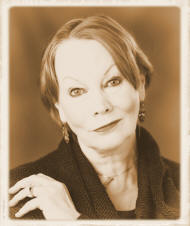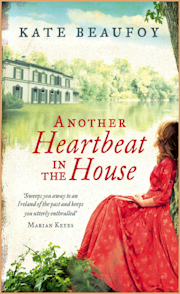
The Irish Times-
15th July 2015

“So, dearest, make the little shirts ready, and the pretty night-caps and we will in a few months go and be married, and have children, and be happy ever after as they are in the story books.”
William Makepeace Thackeray wrote these words to Isabella Shawe in April 1836. She was just 18, Irish-born, fragile and naive: he, a man of the world who, by the age of 25, had squandered a fortune and was leading a bohemian life in Paris.
Thackeray got the girl (and presumably the night-caps), but he did not get the happy-ever-after. Four years after they married, Isabella threw herself overboard a steamship into the Irish Sea. Having borne three children – “with remarkable facility” according to her husband – and been bereaved of one, she was suffering from what would then have been diagnosed as “insanity caused by childbirth”, and today is known as postpartum psychosis.
The family was en route from London to Cork when Isabella made her suicide bid. Thackeray had hoped to leave his wife and daughters in the care of his mother-in-law while he went about earning the advance his publishers had paid him for a guidebook to Ireland. It was a vain hope. Isabella had reached such a “shocking state of [mental] health” that Mrs Shawe refused to take her in, and suggested she be committed to a lunatic asylum.
Women outnumbered men almost two to one in Victorian asylums: if a man wanted rid of his wife, he would simply request two doctors to certify her and then have her incarcerated. It is certain that Thackeray checked out one of the more salubrious hospitals, but he could not bring himself to abandon Isabella there – it made him “quite sick to think of”. Instead, he installed her in a sanatorium near Paris, while he set about scrabbling for any hackwork that would cover her medical bills and feed his children. By the end of his comparatively short life, he had spent a substantial £3,000 (about €300,000 today) on Isabella’s care: she survived him by 30 years.
His guidebook – The Irish Sketchbook – finally got under way two years after his first sojourn. It gives the impression that Thackeray enjoyed a kind of vagabond bachelordom in Ireland, though he found the country “priest-ridden beyond all bearing”. But there is an unease underlying his narrative, a sense that his family is never far from his thoughts.
After Vanity Fair made him a literary celebrity, Thackeray came under attack for his depiction of an Ireland populated by stage peasantry and perky paupers. He rebuffed the criticism, declaring that all he loved best in the world came from Ireland – for it was birthplace of Isabella, his erstwhile beau ideal. However, by the time his masterwork was complete, it had become apparent that she would never recover her sanity, and he was no longer in love with her. The last glimmer of affection was surely extinguished when his eldest daughter confessed that her mother, in a fit of madness, had attempted to drag her into the sea at Margate and drown her when she was just three years old.
We know little of Isabella’s life post-Vanity Fair. Thackeray set her up in a house in Camberwell with a pair of redoubtable female gaolers, and her daughters’ education was given over to a succession of governesses. His mother was insistent that the women he engaged to school her grandchildren should be respectable and – more importantly – plain; in his letters he assured her that that was indeed the case. However, it is evident from his daughter’s memoir that at least one was a looker – a Miss Drury, who was described as possessing “beautiful, dark eyes”.
Miss Drury was in Thackeray’s employ for less than a year. She left towards the end of 1847, by which time the Victorian reading public had become hooked on the monthly magazine instalments of Vanity Fair. In October that year, Charlotte Brontë’s Jane Eyre appeared under a pseudonym. Inevitably a rumour circulated that not only had Isabella provided the template for Rochester’s mad wife, but that the novel had been penned by Thackeray’s governess. No surprise then that Miss Drury had sought to distance herself from any whiff of scandal.
However, Miss Brontë’s Bertha Rochester – bloated, beastlike, purple of countenance and savage of temperament, was the antithesis of Isabella. Isabella was a “little red-poll’d ghost”, whose head had flown away from her “like a balloon”. Nor could Isabella ever be construed as the template for the precociously independent heroine of her husband’s most famous novel. Becky Sharp is resilient, resourceful, audacious, charming, wicked and – most importantly – educated. The only trait Isabella had in common with Becky was the colour of her hair.
I was seeking a heroine for the novel I had embarked upon. So far, I had a title – Another Heartbeat in the House – and a location, a nineteenth-century Irish hunting lodge. But my protagonist eluded me. So I read. I read The Irish Sketchbook, I read several biographies of Thackeray (DJ Taylor’s is the one I am most indebted to), and I re-read Vanity Fair.
What, I conjectured, if Thackeray’s attachment to Ireland had been forged not by Isabella, but by some other femme fatale? He had visited the country twice, and journeyed its length and breadth; it is not inconceivable that a self-described “widower with a wife alive” may have sought comfort and companionship on his travels. A muse may have conjured herself, a clever woman – a governess perhaps, like Jane Eyre, like Becky Sharp, like Miss Eliza Drury …
“Here have we been almost two years married and not a single unhappy day,” Thackeray wrote in a letter to Isabella in March 1838. “Oh I do bless God for this great happiness … so great I almost fear for the future …” Ten years after he dashed off those words, he ended one of the most remarkable novels ever written with this famous aperçu: “Ah! Vanitas Vanitatum! Which of us is happy in this world? Which of us has his desire? or, having it, is satisfied?”
Vanity Fair is subtitled “A Novel without a Hero”. It could equally legitimately be called “A Novel with Two Heroines” – although most readers will concur that Becky ranks second to none. Charlotte Brontë so admired the author that she dedicated Jane Eyre to him. Reader, I am similarly smitten. Not only did I plunder Thackeray’s life, not only did I seek inspiration in his writing; I borrowed some traits from his leading lady, named her after his governess, Miss Drury, and made her my own.